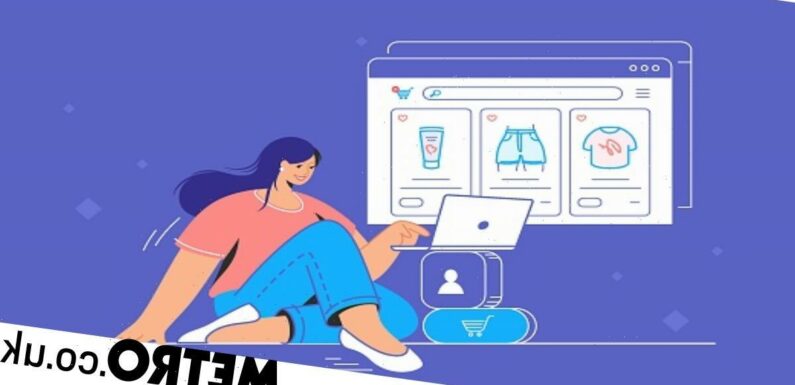
Many of us are guilty of chucking unwanted clothes in a charity bag (or worse, the bin).
But second-hand fashion has seen a boom in recent years, meaning flogging old things online has become easier than ever.
Fashion marketplace Depop has calculated that 18 to 35-year-olds in Britain could pocket an average of £535 extra a year by buying and selling pre-loved fashion.
Unconvinced you could make that kind of money?
We spoke to women who have successfully been using resale apps like Depop and eBay to shop sustainably – and make a lot of money in the process.
Plus, an expert from second-hand marketplace Vinted shares the tips and tricks used by top sellers on the site.
‘I can now sell what my children grow out of’
With a twin son and daughter now aged five, Tessa, 44, from Brighton, feels she accumulates outgrown children’s clothes on a monthly basis.
She started selling items on eBay, but says she found the process too arduous after the site increased the number of fields that sellers had to fill in to describe clothing.
‘You had to put in the material type and then material composition. The number of fields that you had to fill in on eBay just became a bit over the top,’ she claims.
‘Someone told me about Vinted and when I tried it out it seemed too good to be true. It is amazing.’
Tessa has made around £200 on Vinted, and enjoys the fact that the buyer pays the fees and sorts the postage. She also buys clothes for her children and for herself on the app, and has recently enjoyed searching for clothes with ladybirds on them because of the link with her business, Ladybird Plantcare, an organic pest control business.
Tessa says that when she had a problem with clothes from Vinted, it was quickly sorted.
‘I ordered a pair of trousers and when they turned up they weren’t the size they said they were. The seller just told me to give them to the charity shop and Vinted refunded me.’
As well as selling clothes for the twins, Isla and Arlo, Tessa has started selling her own clothes, too. ‘Brands like Hush sell as soon as you put them on. Others take longer,’ she says.
She’s already planning to sell the twins’ winter clothes saved from last year, to help meet the cost of Christmas.
‘I think it’s quite tempting to put on all the summer stuff that they’ve just grown out of – but no one’s going to buy that just now,’ she says. ‘You have to sell things in the right season.’
‘I make up to £2,000 a year selling clothes online’
Branding photographer Melissa Howard started selling clothes on eBay when she was 12-years-old. She’d buy items from charity shops and warehouses to sell online.
‘I’m from a middle-class sort of family, but I’ve always had it really instilled into me that you can earn your own money,’ she explains. ‘So for me, it was a way I can earn money from staying at home.’
Melissa, below, who makes anything from £600 to £2,000 a year selling clothes online, uses different platforms including Vinted and eBay, and says she never pays more than £1 in fees. She explains: ‘The fees have gone up exponentially on eBay, but there are days with £1 selling fees.’
Now aged 33, Melissa, who runs branding photography site MDH Photography, in the Wirral, says that Vinted is better for her for lots of items, especially because she finds it is easier to sell in bundles.
She suggests that, for anyone who wants to get into selling clothing online, the most important thing is to be completely honest about the quality of items.
‘I would say take good pictures. And make sure you’re really explicit about the quality. Because in the nicest way possible, people will try and trip you up if they can. So if there is a rip or a tear or something, make sure that it is pictured and mentioned on there.’
‘I was a second-hand snob… but this has been a game changer’
Opera singer Tricia Rosas-Naylor began buying second-hand clothes during the pandemic, after avoiding them all her life.
‘I was kind of a second-hand snob before,’ explains Tricia, from Leamington Spa, in Warwickshire. ‘I just didn’t want to engage in it, I thought it was kind of weird.
‘Then the pandemic hit. I gained about two sizes and suddenly, I had nothing to wear. And in my head, I was like, right, I’ll just go second-hand, because I don’t invest in clothes that I’m not going to be using for a long time. That’s when my friend told me about Vinted.’ Tricia, who co-runs parenting directory Yoko, now buys and sells her own and her children’s clothes on the app.
‘I love how you can really narrow down exactly what you’re looking for in terms of size, colour, price and condition,’ she says.
‘I’m also interested in sustainability, so this for me has been a game changer.’
Tricia, 34, says she’s excited by all of the clothing she buys, but a recent purchase of a Barbour quilted jacket for £5 has been a particular thrill.
‘I can’t wait for it to arrive,’ she says.
Tips and tricks to become a successful seller:
Natacha Blanchard, Consumer Lead at Vinted writes:
Sell on Sundays
The busiest time for buyers on eBay is Sunday evenings, so schedule your listings to end around that time and choose ten-day auctions to ensure the maximum number of bids.
The longer your item is listed, the more chance of people seeing it, so unless it’s time-sensitive, pick ten days.
Home in on keywords
Take the time to get your keywords right and bidders will come. When buyers search, eBay automatically filters the listing titles, so it’s crucial to write your listing in your fellow users’ language and use the terminology they search for, especially brand and product names.
Be as detailed as possible
By including details that can’t be seen in the image – for example if you are selling clothes, noting the feel or fit of the product – you will help buyers decide if this is the item for them.
Keep prices real
Follow the eBay recommendations. Try searching for similar items on eBay, to make sure you’re going for the right price and always ask yourself ‘would I pay this price for this item?
Pictures paint 1,000 words
Take photos from lots of different angles. Portrait orientations tend to work best on apps. Take your photos in natural sunlight where possible and avoid shadows, to reflect colours and materials more accurately.
Show your worst side
Don’t be afraid to make pictures of flaws. It’s better to show defects, like a stain or a missing button, to avoid discussions and disappointed buyers.
Tell the story
Instead of using a generic ‘I don’t need it’ statement in the description, make the piece more memorable, just by sharing a story about it. This kick-starts a connection with the new potential buyer and your item.
For example, was it the jacket you wore on the first day to your new job? Or was it the backpack that survived your round-the-world travels? This will add even more value to the item, as people love hearing these stories.
Give your buyers options
Some platforms offer integrated shipping options where buyers can choose from a selection before paying, allowing the seller to easily print out the relevant postage label before posting.
Do offer as many options as you can to allow for greater flexibility for the buyer. Some platforms can even work out the postage cost for you if you can provide package dimensions and weigh
Do you have a story to share?
Get in touch by emailing [email protected].
Source: Read Full Article

